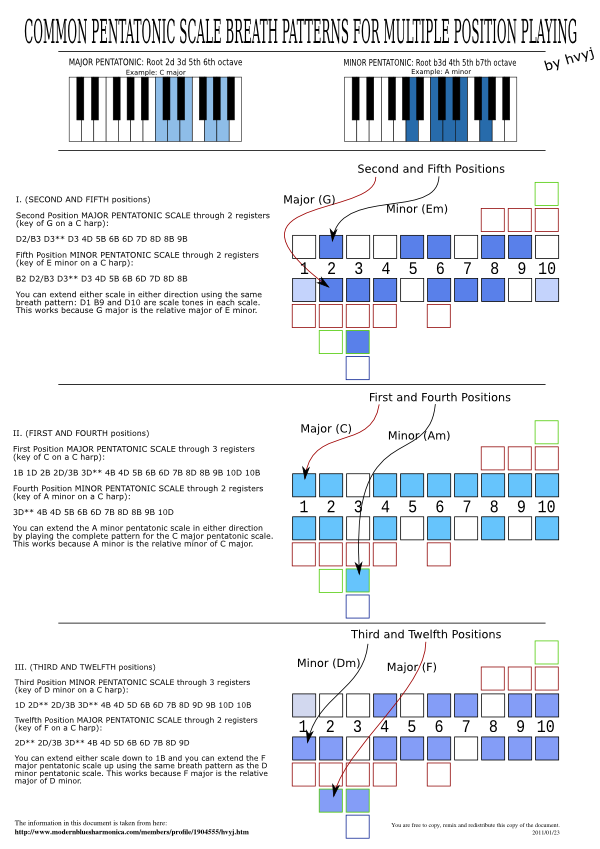|
Dirty-South Blues Harp forum: wail on! >
I memorize scales as lined patterns, do you??
I memorize scales as lined patterns, do you??
Page:
1
Jim Rumbaugh
636 posts
Jan 04, 2012
3:18 PM

|
I want opinions, to see if this is a good graphical concept to explain scales on a diatonic harmonica.
I memorize the scales by envisioning different lined patterns. The patterns I see are a variation of some more common charts. I see it as the higher up and the farther right, the higher the pitch. Here are some examples I sketched.

----------
theharmonicaclub.com (of Huntington, WV)
|
RyanMortos
1218 posts
Jan 04, 2012
3:36 PM

|
What do the line patterns tell you? How do they help? Why do you write the draws at the top & blows at the bottom instead of vise versa?
The old school way of learning where all the notes are on my instruments & learning the notes in each scale & then running the scales up & down the instrument works well for me. Then to top it off turn on a jam track (or play a prewritten song) using only (or mostly) that scale makes the practice musical.
----------

~Ryan
"I play the harmonica. The only way I can play is if I get my car going really fast, and stick it out the window." - Steven Wright
Pennsylvania - H.A.R.P. (Harmonica Association 'Round Philly)
See My Profile for contact info, etc.
|
Jim Rumbaugh
637 posts
Jan 04, 2012
3:50 PM

|
@Ryan
Draws are on top because of higher pitch.
The lines help me see the order to play notes.
If I draw a riff pattern, the lines may be in a triangle shape, etc.
Your questions help me. What I see may not translate to other people. Thanks for the questions
----------
HarmoniCollege March 24, 2012
theharmonicaclub.com (of Huntington, WV)
|
RyanMortos
1221 posts
Jan 04, 2012
4:13 PM

|
It might translate just fine, I'd have to try practicing from your charts a bit to see!
I think it's helpful to have as many different sources for learning as one can get. Some people can learn better from the act of doing while others are more visual learners so it can be helpful!
I didn't mean to insinuate or infer anything negative from my questions. I was more curious how you used them. The question about draws on the top was only because I write out blows on the top draws on the bottom when I write out notes on the harmonica so it made me curious.
----------

~Ryan
"I play the harmonica. The only way I can play is if I get my car going really fast, and stick it out the window." - Steven Wright
Pennsylvania - H.A.R.P. (Harmonica Association 'Round Philly)
See My Profile for contact info, etc.
|
arzajac
715 posts
Jan 04, 2012
5:16 PM

|
I see it in my head like this:
(I see colored boxes in my head when I think about what to hit next)

----------

Last Edited by on Jan 04, 2012 5:17 PM
|
Bugsy
25 posts
Jan 04, 2012
5:37 PM

|
This is how I think, too, but it would make a big difference for me if the draws were on the bottom.
|
FMWoodeye
167 posts
Jan 04, 2012
6:06 PM

|
Well...a lot of my "thinking" is in images. When I played bone in an earlier life, I actually envisioned a staff and the notes when trying to improvise. This put a "hitch" in my mentation and limited my ability to improvise...my opinion. An electric bass player and I took to banging a piano in high school and playing rock tunes. I would see patterns and bang the keys, not knowing what the notes were necessarily. (I could figure them out, but in the moment, it didn't matter.) Long story short -- too late now -- the hitch in my mentation wasn't there during this application. When I took up harmonica (chrom first and then blues harp) I applied the same process. Bingo.
I can now improvise and "sound out" music on harp without thinking of the actual notes, just the patterns. It works for me.
I think our minds work differently and we use different mental processes to execute similar tasks.
Now that I'm taking up bone again, I can transpose harp licks to the bone with a good degree of success. Of course, with the bone I have to actually learn to play the licks in different keys instead of just picking up a harp in a different key.
So if I play something on the harp, I can sit down and tell you how I did it after the fact, but I don't let that process impede on my playing in the moment...if that makes any sense.
I ran into a similar phenomenon, I think, 35 years ago while taking racketball lessons from a gifted athlete. I'd ask a question like, "How did you hit that ball that hard." He would have to stop, analyze, and try to figure out how to communicate to me, that is, he wasn't thinking about weight transfer, swing arc, etc. in the moment. He just did it.
|
Jim Rumbaugh
638 posts
Jan 04, 2012
6:17 PM

|
@Arzajac I also think in terms of "colored boxes, though I did not show it in my graphic
@Bugsy The draw notes on the bottom is the most common, as Arzajac/Hvyj has them. I know it's because the draw plate is on the bottom. My internal visualtzation came 1) before I knew the draw was on the bottom 2) because I like to see the notes ascending in pitch like they do on a regular staff.
Just as Ryan said above, that different people learn differently, I am currious as to how many ways people learn, how they think, and how I should communicate.
----------
HarmoniCollege March 24, 2012
theharmonicaclub.com (of Huntington, WV)
|
Jim Rumbaugh
639 posts
Jan 04, 2012
6:22 PM

|
@FMWoodeye. How do you see the PATTERNS in your head? My patterns are groups of 2 to 5 holes with lines connecting them. Like a map, I follow the lines from one note to the next.
----------
HarmoniCollege March 24, 2012
theharmonicaclub.com (of Huntington, WV)
|
FMWoodeye
169 posts
Jan 04, 2012
7:08 PM

|
On the piano, you'll see that the black keys are pretty much laid out in a blues (rock)scale. Using the black keys (with white keys as chromatic passing tones) the bass player would play the bass line and I would play lead. This would be back in about 1963 when rock was still very rudimentary. After a while, the patterns became burned in my brain...to put it technically. In the late sixties and early seventies I would see the Siegel/Schwall Band whenever I could, and I realized that Corky Siegel played along the same patterns. (Great performer, by the way.) I got my foot in the door playing Corky's stuff and went on from there. Of course, there are many more nuances with harp. On piano, you bang a key and the note flies out. I don't really see the patterns anymore. I sort of "feel" them. A trombone student I'm teaching asked me what the blues scale was. I can play an augmented blues scale in a continuous loop, starting from anywhere on the scale; but to write it down for him on staff paper, I had to stop and think. At this point, I don't even think of specific holes when I'm playing...EXCEPT when I feel the need to "reorient" myself, maybe hit a 4 or 5 or 2 or 3 draw to get myself "back home." It's almost like a typewriter keyboard where if your fingers are off the "home" keys, you can type the same patterns but the letters are wrong. Yeah, the typewriter keyboard is a fair analogy.
I know what I'm trying to say, but it sure looks strange when I see it in print. You should hear me describe my golf swing.
|
colman
113 posts
Jan 05, 2012
4:32 AM

|
I`ve been playing harp since 1968 and i`ve never played scales.I always looked at it as language.Blues is a vocal style of music,licks are words to me.you learn a load of licks and grow in to sentance or paragraph construction.If you dig deep into the style you can get poetic.the closest i come to scales is running left hand piano boogie lines.also. in 1968 there was almost nothing out there to learn blues harp from.So old school assimilation was the way for most players.I`m happy to see harp in .com reality.but i don`t care for players who rip through lot`s of scales with a few blues licks between. I`ll always prefer {james cotton}"Black night" fantastic harp tone and choice of notes over J. Ricci rippin through scales and licks,though i like what he does. just another look at blues harp.......
|
arzajac
716 posts
Jan 05, 2012
4:33 AM

|
The advantage to using lines or arrows is that it is easier to visualize in your head. It may be tougher to visualize the whole scale at once. But the disadvantage of the lines is that if you break the pattern, you are lost. If you just visualize the holes as available boxes and you hit a note outside the scale, you can still find your way back by planning where you want to be in the scale.
I guess I visualize a little more than the colored boxes. I see the root notes in each octave. I just realized that I am way more comfortable in second position because I can see the thirds, fifths and flat sevenths as well in my head but not so much in other positions. Hmmm.... Maybe I'll need to rework that chart....
Maybe what you see in your head changes with time as you play?
----------

|
Post a Message
|